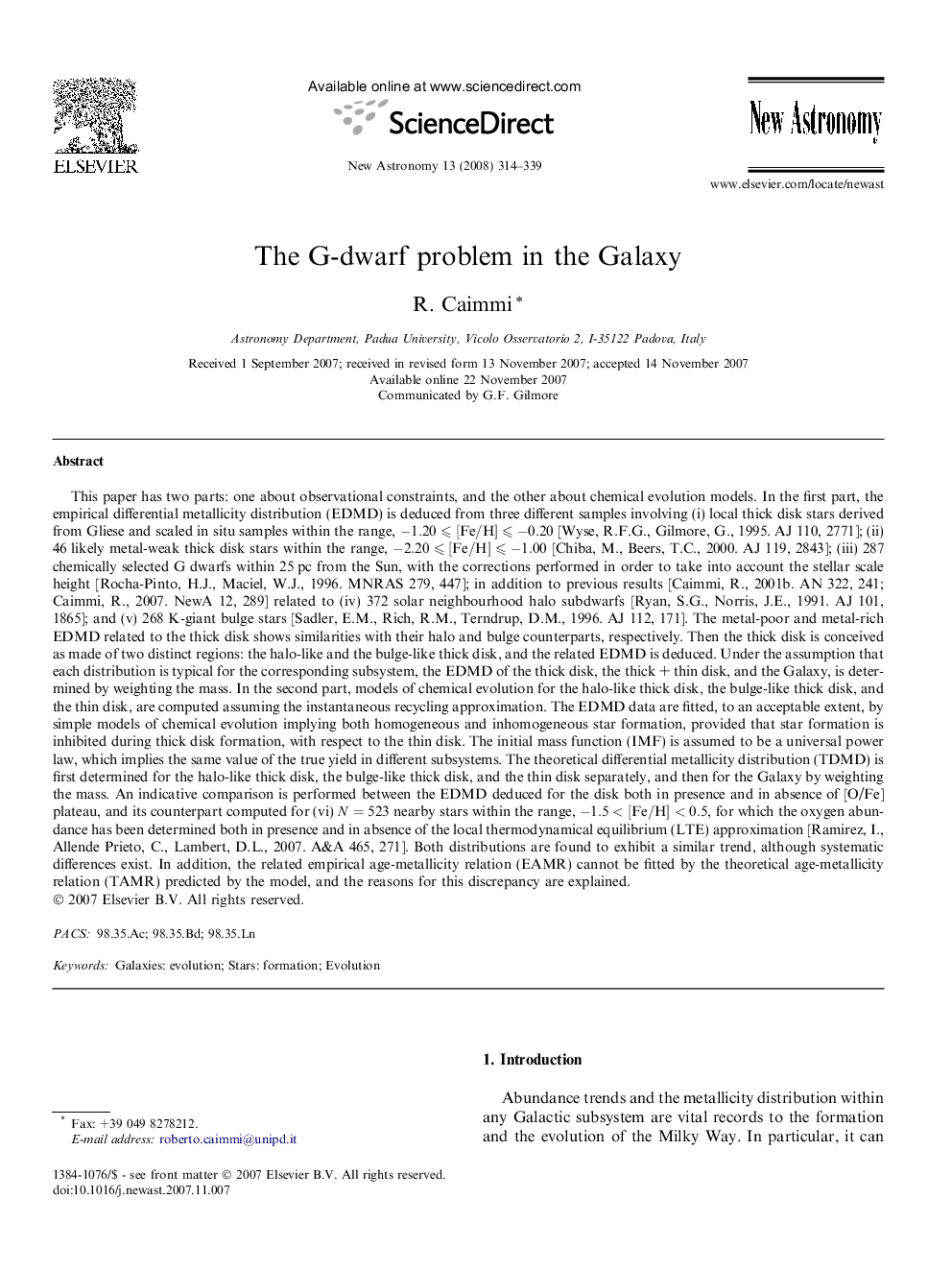| Article ID | Journal | Published Year | Pages | File Type |
|---|---|---|---|---|
| 1779680 | New Astronomy | 2008 | 26 Pages |
This paper has two parts: one about observational constraints, and the other about chemical evolution models. In the first part, the empirical differential metallicity distribution (EDMD) is deduced from three different samples involving (i) local thick disk stars derived from Gliese and scaled in situ samples within the range, -1.20⩽[Fe/H]⩽-0.20-1.20⩽[Fe/H]⩽-0.20 [Wyse, R.F.G., Gilmore, G., 1995. AJ 110, 2771]; (ii) 46 likely metal-weak thick disk stars within the range, -2.20⩽[Fe/H]⩽-1.00-2.20⩽[Fe/H]⩽-1.00 [Chiba, M., Beers, T.C., 2000. AJ 119, 2843]; (iii) 287 chemically selected G dwarfs within 25 pc from the Sun, with the corrections performed in order to take into account the stellar scale height [Rocha-Pinto, H.J., Maciel, W.J., 1996. MNRAS 279, 447]; in addition to previous results [Caimmi, R., 2001b. AN 322, 241; Caimmi, R., 2007. NewA 12, 289] related to (iv) 372 solar neighbourhood halo subdwarfs [Ryan, S.G., Norris, J.E., 1991. AJ 101, 1865]; and (v) 268 K-giant bulge stars [Sadler, E.M., Rich, R.M., Terndrup, D.M., 1996. AJ 112, 171]. The metal-poor and metal-rich EDMD related to the thick disk shows similarities with their halo and bulge counterparts, respectively. Then the thick disk is conceived as made of two distinct regions: the halo-like and the bulge-like thick disk, and the related EDMD is deduced. Under the assumption that each distribution is typical for the corresponding subsystem, the EDMD of the thick disk, the thick + thin disk, and the Galaxy, is determined by weighting the mass. In the second part, models of chemical evolution for the halo-like thick disk, the bulge-like thick disk, and the thin disk, are computed assuming the instantaneous recycling approximation. The EDMD data are fitted, to an acceptable extent, by simple models of chemical evolution implying both homogeneous and inhomogeneous star formation, provided that star formation is inhibited during thick disk formation, with respect to the thin disk. The initial mass function (IMF) is assumed to be a universal power law, which implies the same value of the true yield in different subsystems. The theoretical differential metallicity distribution (TDMD) is first determined for the halo-like thick disk, the bulge-like thick disk, and the thin disk separately, and then for the Galaxy by weighting the mass. An indicative comparison is performed between the EDMD deduced for the disk both in presence and in absence of [O/Fe] plateau, and its counterpart computed for (vi) N=523N=523 nearby stars within the range, -1.5<[Fe/H]<0.5-1.5<[Fe/H]<0.5, for which the oxygen abundance has been determined both in presence and in absence of the local thermodynamical equilibrium (LTE) approximation [Ramirez, I., Allende Prieto, C., Lambert, D.L., 2007. A&A 465, 271]. Both distributions are found to exhibit a similar trend, although systematic differences exist. In addition, the related empirical age-metallicity relation (EAMR) cannot be fitted by the theoretical age-metallicity relation (TAMR) predicted by the model, and the reasons for this discrepancy are explained.
